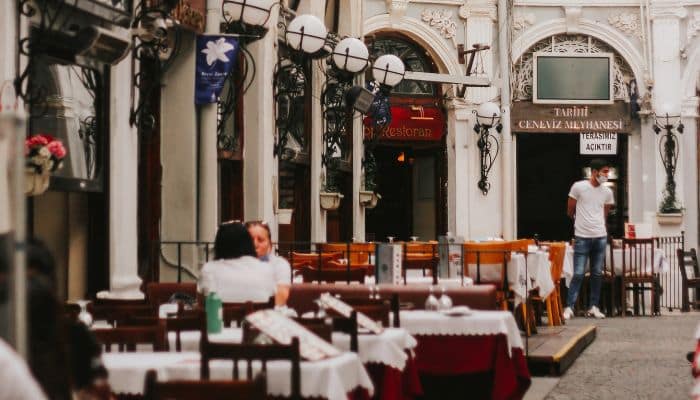Adding an Outdoor Dining Area? Consider These 7 Additions
Outdoor dining has grown quite popular in recent years — and who could blame patrons for wanting to eat al fresco? There is something special about sharing a meal on the patio. When done right, restaurants can cook up the perfect outdoor dining experience.
Creating a space to appeal to customers is the real challenge, requiring creativity and the ability to put oneself in customers’ shoes. What would you hope to experience while eating outside at your restaurant? Here are seven considerations for the ultimate outdoor dining area.
1. Nonslip Flooring
Your outdoor dining space must have a flat surface for people to walk on. According to the U.S. Product Safety Commission, there were 2.6 million emergency room visits for falls related to floors, stairs, ramps and landings, and you want your restaurant to avoid liabilities for injured patrons at all costs.
If you have a patio, what does the surface look like now? Those starting from scratch should select a durable, nonslip surface to ensure customers’ and servers’ safety.
A flagstone patio is elegant, durable and safe to walk on. The materials also come in several colors to match your restaurant’s aesthetic. Although somewhat expensive compared to other outdoor surfaces — materials and labor cost between $750 to $8,400 — it can add value and reduce fall risks.
2. Fencing
If your restaurant’s outdoor dining area is near a busy road or parking lot, consider adding a barrier to protect guests from unforeseen accidents, like a vehicle sliding on slick pavement. An anti-ram bollard can withstand the force of a vehicle and prevent injury.
You must consider the speed limit surrounding your restaurant when choosing an anti-ram barrier. These mechanisms factor in the vehicle weight and speed.
If the speed limit is 30 miles per hour near your restaurant and someone loses control of their car, for example, a K4 barrier would be most suitable for stopping accidents.
3. Canopy or Pergola
A canopy or other covering can protect patrons from the elements. This way, they can still enjoy their meal even if it rains or the sun beats down. Some restaurants also add umbrellas to individual tables.
Another idea is to construct a pergola. Although pergolas don’t provide much protection from rain — they’re open structures — they do throw comfortable shade during the summer. They’re also versatile — you can string lights or hang plants from the rafters.
Patio or table coverings can also add pops of color to your outdoor seating area. Why not invest in yellow and white umbrellas or a bright red royal shade?
4. Lighting
Installing plenty of lights is crucial so people can see where they’re walking. Fortunately, restaurant owners have several options for creating a warm and inviting ambiance:
- Bistro lights are incredibly romantic and reminiscent of Parisian cafés.
- Gas lanterns, overhead fixtures and walkway lights will also make it much easier to find their tables and avoid tripping.
- Tea lights or battery-operated candles offer greater intimacy among diners. These sorts of lighting features are decorative above all else but make a significant difference in setting the right mood.
5. Heating Feature
Outdoor dining may only be optional for part of the year where you live. However, you can prolong it by adding heating features.
Some restaurants have begun offering dining igloos in winter, where guests can enjoy private meals in enclosed, heated spaces — but you need the space for it. Other restaurants invest in standing heaters and heating lamps to keep customers warm during cooler evenings or seasonal changes.
Another idea is to include a cozy fire feature in your outdoor space, like a fire pit or tabletop fireplace. You have plenty of styles to choose from, depending on the patio’s size and safety requirements. Fire pits for commercial locations will likely require a permit and a professional installer.
6. Greenery
Plants are visually appealing in every outdoor setting, but especially while dining. Aside from purifying the air and creating a sense of well-being, lush greenery absorbs noise, which is important considering a full patio of customers can be just as loud as inside the restaurant.
Incorporate plants as dividers between tables or hide whatever fence structure you put up. This will help create a cozier atmosphere. You can even decorate dining tables with small potted succulents.
Restaurant owners must be strategic in purchasing plants for patio dining. Greenery should be well-adapted to your local climate, easy to maintain and long-lasting. You also want to avoid anything customers might be allergic to. Japanese maple, tulips, begonias, spider plants, ferns, bamboo and boxwood are usually safe options.
7. Water Feature
Customers will enjoy the trickling sounds of water during their outdoor dining experience. Do you have a wall you can install a fountain on? Fountains exude elegance and come in various shapes, sizes and colors.
You might even decide to set up seating around a sizeable fountain in the center of your patio. A taller water feature in the center can block people’s views of other tables, delivering some privacy.
Some fountains have light-up features, come with a statue or intricate tiles, or lean into a style like French countryside or modern.
Create a Magical Meal Under the Stars
The perfect outdoor dining experience is the culmination of excellent food, world-class customer service, great friends and an enchanting atmosphere. If customers wanted ordinary, they could eat at home. Create a beautiful space for al fresco dining, and customers will surely want to return.



Comments are closed.